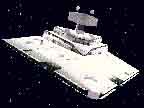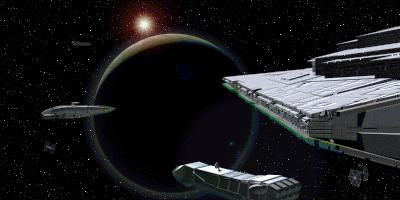Imperial Star Destroyers and other Capital Starships


 Also known throughout the galaxy as the Emperor's capital ships, Imperial Star Destroyers provide the main military might of the Empire. Built by command of Palpatine at a rate that forced all normal safety precautions to be discarded, these vessels served to establish the primary foothold of the Emperor's rule.
Also known throughout the galaxy as the Emperor's capital ships, Imperial Star Destroyers provide the main military might of the Empire. Built by command of Palpatine at a rate that forced all normal safety precautions to be discarded, these vessels served to establish the primary foothold of the Emperor's rule.
These colossal, wedge-shaped behemoths, bristling with turboweapons and carrying entire TIE squadrons within them, each possess more firepower than the entire planetary forces of most worlds, and can reduce a planet surface to smoking debris in a matter of hours. An Imperial Star Destroyer, typically 1.6 kilometers in length (1 mile), is equipped with 60 turbolaser emplacements and 60 ion cannon batteries. Each turbolaser is a supercharged beam weapon that uses a small laser to excite its main component system to fire. A turbolaser's beam is hotter and more intense than that of an ordinary blaster cannon, and its discharge muzzle reaches such high temperatures that three separate cryogenic sooling systems are necessary to keep the weapon within safe thermal limits. The vessel's ion cannons, similar to those most often found as part of planetary defense systems, give the Star Destroyer the ability to neutralize the energy systems of other vessels as an aid to capture and boarding.
A Star Destroyer also carries three TIE fighter squadrons for perimeter defense and reconnaissance, two TIE interceptor squadrons, one TIE bomber squadron, eight Imperial shuttles, a full stormtrooper division and 15 stormtrooper transports, building materials, landing barges, scouts, field artillery weapons, both AT-AT and AT-ST walker groups (for ground assault missions), special ablative heat shields for orbital drops, assault gunboats, repair vessels, deep-space probes and probe droids, 10 tractor beam projectors, defensive shields, and sophisticated sensor and communications arrays.
The vessel's upper command tower with its characteristic twin shield generators serves as the brain of the ship. The main bridge, located in the center of the tower's forward face, features large viewports which provide a spectacular view of space beyond and of the massive forward hull. As they do in many Imperial vessels, flight data officers, tracking systems specialists and combat supervisors work in sunken data pits that line the room's floor.
The ventral side of the Imperial Star Destroyer features two launch bays, both along the vessel's centerline. They largest of these is of sufficient size to allow the docking/capture of any vessel at or below the dimensions of a Corellian Corvette (or Blockade Runner, as it is sometimes called). From this same bay, the ship's TIE squadrons and probes are launched as well, dropping from holding racks along a wide, vertical shaft that reaches well into the main body of the ship.
 A smaller launch bay, just forward of the main one, serves as a drop chute for any ground assault equipment the vessel chooses to deploy. Three AT-AT walkers can be dropped per minute, carried in landing barges and unloaded. Such large ground equipment is later retrieved using specially-outfitted shuttle barges. Alternately, when time is not a factor, walkerts can be both delivered to and removed from a combat zone by shuttle barge carrier.
A smaller launch bay, just forward of the main one, serves as a drop chute for any ground assault equipment the vessel chooses to deploy. Three AT-AT walkers can be dropped per minute, carried in landing barges and unloaded. Such large ground equipment is later retrieved using specially-outfitted shuttle barges. Alternately, when time is not a factor, walkerts can be both delivered to and removed from a combat zone by shuttle barge carrier.
The ship's huge hyperspace field generator is located within a domed area along the vessel's ventral ridge. It is the largest such generator ever constructed (with the exception of Death Star I and II), and it expends more raw energy in a single hyperspace jump than many planetary nations use during their entire lifetimes. Containing what is in essence a miniature sun, the heavily-shielded, carbonite and durasteel-reinforced hear of the ship's SFS Ia2b solar ionization reactor was the one element that dicatated the enormous size of the Imperial Star Destroyer. It feeds not only the hyperdrive motivation system, but the vessel's propulsion, powerfeed and weapons networks as well, providing more than enough focused power for any task facing a Star Destroyer.
The standard Star Destroyer carries a complement of 37,085 (4,520 officers, 32,565 enlisted). Much of its interior space is necessarily dedicated to providing quarters for the enormous crew, and other areas (unlike most Imperial ships) feature recreation facilities for off-duty personnel, In addition, quarters are provided for the vessel's always-ready planetary assault troops and for any Imperial VIPs or planetary government officials who the Emperor feels should spend time as "guests" aboard one of his massive and intimidating Imperial Star Destroyers.
There are no raw materials recycling facilities aboard Imperial Star Destroyers, as there are within Dreadnaughts and Super Star Destroyers. As a result, most commanders simply eject repair debris and waste materials into space, usually before engaging the vessel's hyperdrive systems. This procedure often wreaks havoc with the shipping lanes that surround most inhabited planets, but few local officials dare to complain.
A Sector Group of 24 Imperial Star Destroyers is assigned for the patrolling of each sector of space. With the added reach of TIE squadron patrols, a single vessel can easily hold a star system within its grip, forcing its inhabited worlds to comply with any Imperial edict that is handed down. The placement of stormtrooper patrols on planetary surfaces is seldom neccessary, but it is an option left to each Star Destroyer commander.
 Standard Imperial fleet tactics generally calls for the deployment of these vessels during planetary assault and invasion maneuvers. Star Destroyers also provide protective escort, in fleet battle formation, for the Super Star Destroyers developed since the standard Star Destroyer first went into service.
Standard Imperial fleet tactics generally calls for the deployment of these vessels during planetary assault and invasion maneuvers. Star Destroyers also provide protective escort, in fleet battle formation, for the Super Star Destroyers developed since the standard Star Destroyer first went into service.
The first of the Super Star Destroyers, the Executor, was built for Lord Darth Vader as his personal flagship. More than four times the length of a standard Star Destroyer, the colossal Executor was the largest vessel in space, with the sole exception of the Death Star itself. After losing all navigational control in a collision during the Battle of Endor, the Executor was pulled down by the Death Star's gravity field, crashed into the surface of the battle station, and was destroyed only moments before the Death Star itself exploded.
The second known Super Star Destroyer was the Lusankya comandeered by the Empress, Ysanne Isard. Lusankya was buried beneath the surface of Coruscant for some unknown time, then erupted out of the ground and fled to the Thyferra system where it was captured by the New Republic in the Battle of Thyferra.
The third was the Mega Star Destroyer, built by the cloned Emperor. It was more than twice as long as a Super Star Destroyer, approximately ten miles in length. It was destroyed by one of the Emperor's Force Storms over the planet of ....
A fourth Super Star Destroyer was the Night Hammer built by the late Admiral .... He died at the hands of Daala before he could use it and she took over, re-christening it the Knight Hammer. It went on to Yavin 4 where it was supposed to lay waste to the Jedi Knights. Unfortunately, Rebel reinforcements arrived and Knight Hammer was devastated by the attack. The great vessel was sucked into the planet by it's gravity and subsequently exploded.
The fifth and last known Super Star Destroyer was the Pride of Yevetha. The aliens took over the Black Fleet, including the ship. A captain regained control of the ship during the Battle of Yevetha, by using slave circuits which were also in the other Imperial vessels. The Black Fleet retreated into the Core Systems and is now under the captain's control.

The earliest version of the Imperial Star Destroyer, the Victory-class Star Destroyer is smaller and less sleek than the newer combat capital ships. While a few still serve in the Imperial fleet, most of the remaining Victory Star Destroyers are employed by local system defense forces and large conglomerates like the Corporate Sector Authority. Measuring a kilometer in length, these space fortresses were once considered to be the ultimate weapons of war.
The Victory-class Star Destroyer is a 900-meter-long combat starship designed by Republic engineer Walex Blissex near the end of the Clone Wars. Those still in Imperial service carry two squadrons of TIE fighters (twenty-four ships), and have the basic armament: ten quad turbolaser batteries, forty double turbolaser batteries, eighty concussion-missile launchers, and ten tractor-beam projectors.

Using the shell of a 600-meter-long heavy star cruiser, the Interdictor-class cruiser was designed to serve a specific purpose in the Imperial fleet. The core of this vessel is a massive gravity-well generator and its four gravity-well projectors. The projectors emit waves of energy that disrupt the mass lines of realspace, simulating the presence of a true stellar body. This displacement of mass lines serves two purposes: first, ships within the sphere of influence of a gravity well cannot engage their hyperdrives and second, ships traveling through hyperspace that come in contact with the resulting gravity shadow must drop back into realspace when their hyperdrive cutoffs kick in. Thus, Interdictors prevent lightspeed escapes by enemy ships, and ambush those ships traveling the hyperspace lanes by forcing them to shift back into realspace so that an Imperial armada can pounce on them.

The 300-meter-long Nebulon-B escort frigate class combat starship was originally built by the Kuat Drive Yards for the Empire. The Empire saw this vessel as the solution to its problems with Rebel raids on supply convoys. Standard equipment included twelve turbolaser batteries, twelve laser cannons, two tractor-beam projectors, two squadrons of TIE fighters in its bays, and powerful hyperdrives. The escort frigate proved a great deterrent to Rebel attacks. Unortunately, a significant number of these vessels either defected or were captured by the Rebellion and now serve in the Alliance fleet.

The 450-meter-long Imperial Strike-class medium star cruiser was designed to be mass-produced in a short span of time. This triumph of the Empire's modular design philosophy is made up of prefabricated component sections. Introduced near the end of the Galactic Civil War, the Strike-class cruiser continues to serve an important role in the remnants of the Imperial fleet under the command of Grand Admiral Thrawn.It is one of the few vessels that can still be turned out with regularity by the Empire's remaining construction centers. Thanks to their modular design, the cruisers' interiors can be configured to accommodate specific mission profiles. Some have room to carry a ground assault company, including troops, two AT-STs, one AT-AT, and a limited number of support speeders. Others are modified to make room for a complete squadron of TIE fighters. Other configurations include prefab garrison deployers, troop transports, and planet assault cruisers packed with five AT-ATss for surgical deployment. Strike cruisers normally carry twenty turbolasers, ten turbolaser batteries, ten ion cannons, and ten tractor-beam projectors.